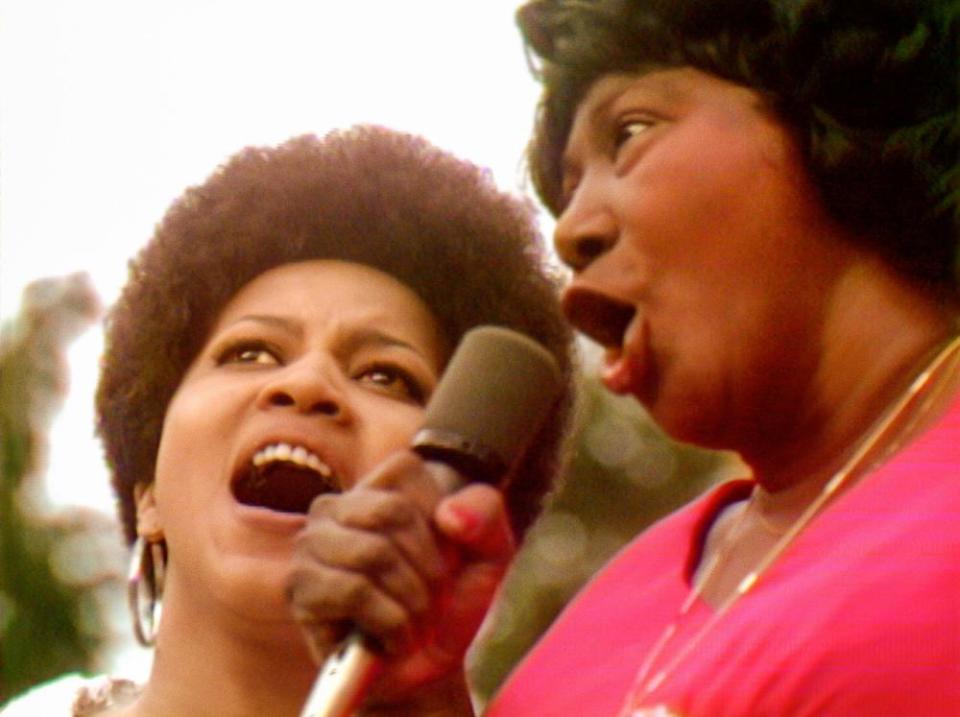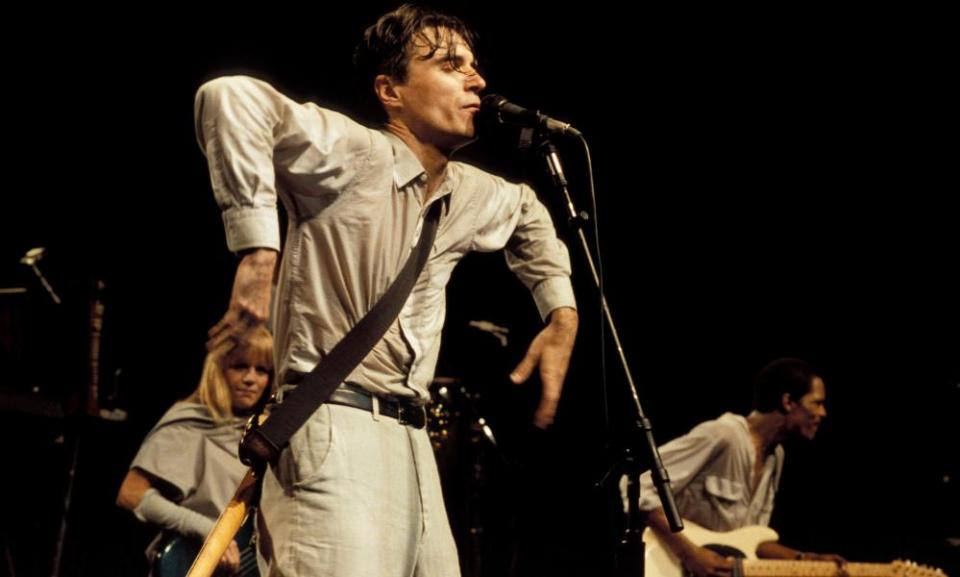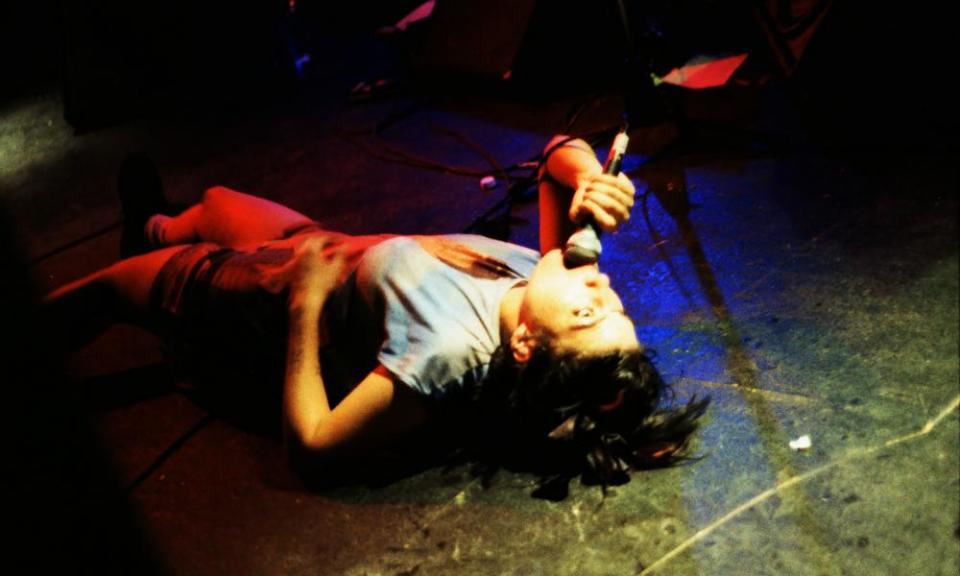Monsters of doc: Mark Kermode’s top 20 music documentaries
Reviewing Summer of Soul in the Observer New Review last year, I suggested that it might be “the best concert film ever made”. Since then, I’ve rewatched the movie umpteen times and come to the conclusion that it’s actually my favourite pop music documentary of all time. That should tell you two things about my obviously very personal list of great pop docs: first, that concert movies and rock docs are both part of the same generic continuum, interwoven and often inseparable; second, that although many of the most celebrated examples of the genre hail from the 60s and 70s, I believe we are living through a golden age of pop music docs.
A cursory glance at my list will reveal that several of my highest ranking entries are from the recent past. Yet in the case of films such as Summer of Soul, Amazing Grace and The Beatles: Get Back, they are also archival works that revisit material originally generated for previous film and TV projects many decades ago. Just as Peter Jackson’s The Beatles: Get Back embraced the medium of long-form television to counterbalance the fraught air of the 1970 cinema release Let It Be, so Amazing Grace used modern technology to rescue previously unsalvageable footage of Aretha Franklin that Sydney Pollack shot for an abandoned feature in the early 70s. As for Summer of Soul, it’s a perfect combination of cultural archaeology and forward-looking celebration.
Many a time I’ve sat in a cinema thinking that this must be the very best way to experience a live concert
As always with lists, there are inclusions and omissions that many will find baffling and infuriating. Why, for example, have I included the relatively little-seen British doc Heavy Load while excluding Martin Scorsese’s epochal The Last Waltz, or the crowd-sourced Awesome; I Fuckin’ Shot That!? How come I found space for a TV doc about Queen but left out Mike Wadleigh’s Woodstock, perhaps the most famous concert film of all time? And where are classics such as Dont Look Back and Soul Power?
The answer is simple. Like the narrator of Nick Hornby’s High Fidelity, the list of titles I hated to leave out was far longer than those I got to keep in. What I have tried to do is to chart an admittedly erratic course from early milestones such as Jazz on a Summer’s Day to more modern offerings such as Dig! and Moonage Daydream to give some sense of the vast and unwieldy scope of the genre and its subjects – from low-budget obscurities to Imax-friendly blockbusters; from cool blues to frantic post-punk via unearthed Afro-Cuban history.
I’d also like to point out that as someone who fears large festival crowds (there’s a reason Gimme Shelter ranks so high in my list), music docs have been my way into a wealth of live music performance. Many a time I’ve sat in a cinema thinking that this must be the very best way to experience a live concert – from the security of the last aisle seat on the left, in a darkened auditorium where there is nothing to do but succumb to the music. For me, great music docs are not a record of something – they are the main event.
The 20 best music documentaries, chosen by Mark Kermode, in ranking order
1. Summer of Soul (Questlove, 2021)

Director Ahmir “Questlove” Thompson’s Oscar- and Bafta-winning feature debut intertwines music and politics in a joyous cocktail of history and concert footage, uncovering a treasure trove of pulse-racing, heart-stopping live music (originally captured by TV veteran Hal Tulchin) that remained largely unseen for half a century. Subtitled Or, When the Revolution Could Not Be Televised, this makes classics such as Woodstock seem like a footnote to the main event of 1969: a festival in the heart of Harlem that was somehow written out of the history books. Capturing Stevie Wonder at a turning point in his career, Mavis Staples duetting with Mahalia Jackson (“an unreal moment”, says Staples) and Nina Simone at the height of her performing powers, it’s an absolute blast. Oh, and the 5th Dimension are on fire!
2. Gimme Shelter (Albert and David Maysles, Charlotte Zwerin, 1970)
Less a concert-film than a real-life horror show, the Maysles brothers and Charlotte Zwerin’s account of the Rolling Stones’ 1969 US tour that ended with the catastrophic Altamont concert is one of cinema’s most chilling experiences. Dissecting a disaster foretold, this urgent account moves inexorably toward chaos and tragedy as hippies and Hells Angels converge upon a desolate speedway track where the sunny dreams of the 60s come to an ugly, violent end. As with Robert Frank’s unreleased Cocksucker Blues, filmed in 1972, sympathy for the Stones is in short supply.
3. Wattstax (Mel Stuart, 1973)

“Laugh! Cry! Sing! Dance! Shout!” Publicity for this “soulful expression of the black experience” boasted “100,000 brothers and sisters turning on to being black”, with the Rev Jesse Jackson promising an ecstatic crowd “gospel and rhythm and blues” aplenty. Footage from the August 1972 benefit concert organised by Stax Records around the seventh anniversary of the Watts riots (six days of anti-police/discrimination civil unrest in the LA neighbourhood in August 1965) is augmented by additional musical performances, documentary footage of Watts residents, and interstitial hosting by Richard Pryor. Isaac Hayes turns 30 in style; Rufus Thomas does the Funky Chicken.
4. Oil City Confidential (Julien Temple, 2009)
Julien Temple, who made features such as Absolute Beginners and docs including The Filth and the Fury, brings his trademark cultural cut-up technique (a kaleidoscopic melee of film, music and popular history) to bear on Canvey Island’s finest, British rhythm and blues pioneers Dr Feelgood, with electrifying results. Rarely has pub rock seemed more dark, daring and deliciously dangerous than in this blistering account of the Feelgoods’ “Thames delta” blues. See also Temple’s The Ecstasy of Wilko Johnson – a fitting tribute to the legend who died last week.
5. Moonage Daydream (Brett Morgen, 2022)
There’s more than a touch of Temple’s pop-culture car-crash aesthetic in the way director Brett Morgen uses fragments of films (Un Chien Andalou, The Wizard of Oz, 2001: A Space Odyssey, A Clockwork Orange) to illustrate this “maximalist” portrait of David Bowie, one of pop’s most chameleonic icons. Scenes from The Man Who Fell to Earth are juxtaposed almost indistinguishably with clips from the TV documentary Cracked Actor, while concert footage of Bowie’s ever-changing personas (Ziggy Stardust, The Thin White Duke etc) reminds us what a force he was on stage. It’s a wild ride, from disposable glam-pop culture to timeless matters of life and death via mime, painting, acting, animation, dance and extravagant costumery.
6. The Beatles: Get Back (Peter Jackson, 2021)
Described by director Peter Jackson as “a documentary about a documentary”, this three-part TV series (which runs to nearly eight hours) draws on a treasure trove of unseen footage originally shot for Michael Lindsay-Hogg’s fractious 1970 doc Let It Be. The result plays like a meditative slow-cinema exploration of the creative process, creating an uncanny illusion of intimacy. A spin-off short feature presented footage of the rooftop concert with enhanced audio for added cinematic oomph.
7. Amazing Grace (Alan Elliott, Sydney Pollack, 2018)
Director Sydney Pollack’s 16mm footage of Aretha Franklin’s two-night performance at the New Temple Missionary Baptist church in Los Angeles in 1972 remained unseen for decades because of synching issues between picture and sound. Previously unavailable digital technologies allowed Alan Elliott (who gets a “realised and produced by” credit) to fix the glitch in the 21st century, but legal issues were only solved in the wake of Franklin’s death, turning a celebration into an elegy. A genuinely religious experience.
8. Jazz on a Summer’s Day (Bert Stern, Aram Avakian, 1959)
Louis Armstrong, Mahalia Jackson, Gerry Mulligan, Dinah Washington, Thelonious Monk, Anita O’Day, Chuck Berry – all these and more are captured in this film of the 1958 Newport jazz festival, hailed in its publicity as “a picture that’s high on happiness… long on longing!” Focusing not just upon the acts but also the mood of the audience and the atmosphere of the time, photographer Bert Stern and co-director and editor Aram Avakian essentially set the template for a swathe of celebrated rock docs that would follow their seminal work. This is ground zero.
9. Heavy Load (Jerry Rothwell, 2008)
Subtitled “A Film About Happiness”, this wonderful portrait of the British punk band Heavy Load (not to be confused with the Swedish rockers of the same name) presents a thrilling riposte to disablist prejudices and stereotypes, offering a slice of real rebellion. “Most people that play music just do it exactly the same as the way other people do it, because that’s conformity,” says DIY troubadour and post-punk singer-songwriter legend Wreckless Eric. “But they are completely nonconformist, and I love it.” While the film flies the flag for the Stay Up Late campaign (a charity challenging “inflexible support systems that prevent people with learning disabilities from staying up late”), the band redefine the Kylie hit Can’t Get You Out of My Head in irresistible, earworm fashion.
10. Monterey Pop (DA Pennebaker, 1968)

“Monterey is very groovy, man!” Like Jazz on a Summer’s Day a decade earlier, and Mike Woodleigh’s Woodstock a couple of years later, this film of the 1967 Monterey international pop festival is as much about the crowd and the culture as it is about Jimi Hendrix setting his guitar on fire on stage. DA Pennebaker, who revolutionised rock docs with 1967’s Dont Look Back, utilises roving cameras to put the audience at the centre of the action. The Who, Janis Joplin, Jefferson Airplane and Ravi Shankar play blinders, but Otis Redding steals the show.
11. The Decline of Western Civilization Part II: The Metal Years (Penelope Spheeris, 1988)
Having dug into the grassroots, under-the-radar Los Angeles punk scene in The Decline of Western Civilization (1981), Penelope Spheeris discovers what happens when money, swimming pools and poodle perms are dropped into the mix, taking a deep dive into late-80s heavy metal. The result is a Roman orgy of posturing, hairsprayed madness, featuring the likes of Aerosmith, Kiss, and Poison, alongside lesser-known rock-god wannabes. Ozzy Osbourne showcases the lovable domestic persona that would later define the reality TV hit The Osbournes, while W.A.S.P. guitarist Chris Holmes floats drunkenly on a lilo, watched over by his quietly disapproving mother. Tragicomedy at its most absurd.
12. Anvil! The Story of Anvil (Sacha Gervasi, 2008)

While Rob Reiner’s mockumentary This Is Spinal Tap (1984) took its lead from Scorsese’s The Last Waltz (1978), Sacha Gervasi gives us a real-life Spinal Tap in the form of these never-quite-made-it Canadian heavy metal grafters. There’s palpable Tufnel-and-St-Hubbins energy in the relationship between Robb Reiner (yes, really) and Steve “Lips” Kudlow, love-hating heroes still harbouring dreams of stadium success while holding down day jobs delivering school meals in the snow. How much more brilliant could it be? None more brilliant!
13. Stop Making Sense (Jonathan Demme, 1984)

Talking Heads were at the peak of their performance skills when film-maker Jonathan Demme (who would go on to win an Oscar for The Silence of the Lambs) filmed them over three nights at the Pantages theatre in Hollywood in 1983, mixing tracks from their new album Speaking in Tongues with fresh versions of hits such as Psycho Killer, played on a boombox and acoustic guitar. Thirty-six years later, Spike Lee would work similar wonders on David Byrne’s American Utopia.
14. The Devil and Daniel Johnston (Jeff Feuerzeig, 2005)
Johnston’s obsessive self-taping provided a wealth of material upon which film-maker Jeff Feuerzeig could draw for this devastatingly intimate insight into the mental health struggles and bewildering artistic achievements of his unique subject. It’s not an easy watch at times, but Feuerzeig takes a sober and responsible approach to the bipolar disorder that both fired and hampered Johnston’s songwriting and art. The result is simultaneously heartbreaking and uplifting.
15. Buena Vista Social Club (Wim Wenders, 1999)
The German director Wim Wenders (who won the Palme d’Or for Paris, Texas) explores the story of how a multigenerational group of Cuban musicians, corralled by Ry Cooder and Juan de Marcos González, recorded a hit album and took to the stage worldwide, with concert footage recorded in 1998 in front of adoring audiences in Amsterdam and New York. It’s an invigorating watch, with a soundtrack that now seems so familiar it’s hard to remember a time when these songs were not global anthems.
16. Dig! (Ondi Timoner, 2004)
Blimey! Rarely has a film-maker got as far inside a battle of the bands as Ondi Timoner does in this no-holds-barred look at the parallel rock careers of Vodafone advert soundtrackers the Dandy Warhols and disaster artists the Brian Jonestown Massacre. “I sneeze and hits come out!” declares Dandys frontman Courtney Taylor-Taylor, while the Massacre’s Anton Newcombe picks fights with his own band on stage at record company showcases, thereby scuppering any potential success. A cautionary tale with blood and teeth.
17. The Punk Singer (Sini Anderson, 2013)

The story of rebel girl Kathleen Hanna is retold by documentarian Sini Anderson in fascinating fashion. From the formation of Bikini Kill and the rise of the riot grrrl movement to the emergence of Le Tigre and battles with Lyme disease, The Punk Singer reminds us that Hanna is a genuine force of nature. Whether facing down macho morons or penning infectiously catchy post-punk hits, she is the real deal, and this doc does her proud.
18. What Happened, Miss Simone? (Liz Garbus, 2015)
Film-maker Liz Garbus does an impressive job of capturing the sheer force (personal, political, musical) of Nina Simone, one of the star turns of Summer of Soul. Rare and unreleased archive material mixed with insightful interviews offers a window into Simone’s life that leaves us wanting much more. If you enjoy this, then try Warren Ellis’s book Nina Simone’s Gum, which is equally transfixing, albeit in a very different way.
19. Amy (Asif Kapadia, 2015)
Winehouse characterised her songwriting as being confessional with punchlines, providing a key to Asif Kapadia’s unsensational and overwhelmingly sad Oscar-winning film about her short and volatile life; from her childhood in Southgate, London, to global superstardom. In the absence of narration, Winehouse’s lyrics tell the story, floating on the screen in a handwritten font that creates the illusion of a coherent diary. Home video captures the emergence of her prodigious talent, while footage of her in the recording studio and on stage reminds us that, behind the garish headlines, she was a genuine musical maestro.
20. Queen: Days of Our Lives (Matt O’Casey, 2011)

The fact that director Matt O’Casey is himself a talented musician allows Brian May and Roger Taylor to dig beneath the surface and get to the heart of what made Queen great – in terms of their showmanship and their songwriting skills. Broadcast in two parts on the BBC but given a theatrical airing in some European/South American territories, this is the real story, and offers a fascinating counterpoint to the altogether more fanciful Oscar-winning drama Bohemian Rhapsody.

 Yahoo Movies
Yahoo Movies 
